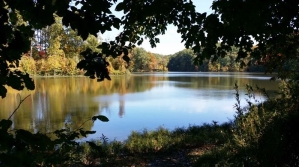Rather than kicking natural Christmas trees to curbs for city solid waste pickup, more Americans are donating holiday trees to organizations whose employees and volunteers can repurpose them for wildlife, fish or recreational environments. For example, Missouri Department of Conservation (MDC) representatives have collected natural Christmas trees for more than 25 years to recycle as fish habitats in local lakes. By weighing down the donated pine and cedar trees, the interlocking branches create a network where small fish gather, reproduce and feed.
Scott Voney, MDC's fisheries management biologist, works with parks and recreation departments to create drop-off locations where residents can haul their natural Christmas trees to be sunk and recycled as fish habitats.
Voney also travels to stores and other drop-off sites to collect trees and recycle them this way.
When it's time to dump the trees, he uses cables to connect cinderblocks to the trees and sinks them on top of the brush pile from the previous year. These piles are created in eight feet of water or less where the oxygen levels are higher and attract more fish, he told the Fulton Sun.
Voney said these habitats are important for newborn fish, which need a place to hide from bigger fish.
Some state conservation groups also mulch donated trees for other uses. "It's a good idea to remove ornaments and lights before dropping them off," Voney said.
National Christmas Tree Association staffers offer the following additional tips for reusing trees:
Soil erosion barriers: Some communities use Christmas trees to make effective sand and soil erosion barriers, especially for lake and river shoreline stabilization and river delta sedimentation management. For example, Christmas trees are helping the sand dunes in New Jersey recover from Hurricane Sandy.
Bird feeders: Place Christmas trees in gardens or backyards, and use them as bird feeders and sanctuary. Fresh orange slices or strung popcorn will attract the birds, and they can sit in the branches for shelter. (Make sure all decorations, hooks, garland and tinsel strands are removed). Eventually, within a year, the branches will become brittle and you can break the tree apart by hand or chip it in a chipper.
Mulch: A Christmas tree is biodegradable; its branches may be removed, chipped, and used as mulch in the garden.
Paths for hiking trails: Some counties use the shredded trees as a free, renewable and natural path material that fits both the environment and the needs of hikers.

For information or guidance about how to start and promote a holiday tree recycling program, send an email to info@realchristmastrees.org
Examples of how some communities are applying recycled Christmas trees are:
Animal Enrichment at Busch Gardens - Williamsburg, Virginia
Salmon Spawning - Northwest Oregon
Rebuilding an Island - Easton, Maryland
Wildlife Habitat - Porter County, Indiana
Mulch for Planting - Georgia
Dune Restoration - Gulf Shores, Alabama
Rebuilding the Louisiana Coastline - Jefferson Parish, Louisiana
Home for the Herons - Cook County, Illinois
Giving Back to the Community - San Diego, California
Improving Fishing Areas - Keene, New Hampshire
Building Better Parks - Clarksville, Tennessee
Fueling Our Nation's Industry - Tomahawk, Wisconsin
Turning Trees into Electricity - Burlington, Vermont
Many Home Depot locations across the country offer Christmas tree recycling free of charge. Call your local Home Depot store to find out if they are participating. If not, Earth911 offers a handy search tool to locate Christmas tree recycling options near you.







